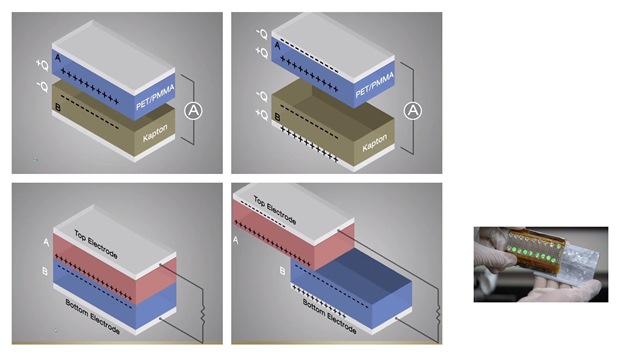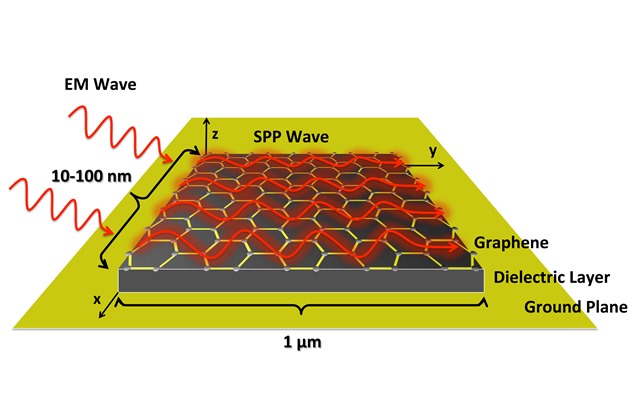Researchers at Georgia Institute of Technology, aided by colleagues at other institutions, are rapidly developing essential elements for a network of independent machines with nanometric dimensions that could be the basis for new medical treatments, advanced system maintenance, and remote manufacturing. Two recent projects, one involving power generation and the other intermachine communication, seem to offer solutions to fundamental challenges.
Zhong Lin Wang, a Regents professor in Georgia Tech’sSchool of Materials Science and Engineering, leads a group of researchers developing a family of power generators that take advantage of the triboelectric effect to produce electricity in surprising amounts. “The fact that an electric charge can be produced through triboelectrification is well known,” Wang notes. Anyone who has walked across a wool rug on a dry winter’s day and then touched another person, door knob, or other conductor to produce a static-electricity shock will agree. “What we have introduced is a gap separation technique that produces a voltage drop, which leads to a current flow in the external load, allowing the charge to be used. This generator can convert random mechanical energy from our environment into electric energy.”
In its simplest form, the researchers’ triboelectric generator uses two sheets of dissimilar materials, one an electron donor, the other an electron acceptor (Fig.1 ). When the materials are in contact, electrons flow from one material to the other. If the sheets are then separated, one sheet holds an electrical charge isolated by the gap between them. If an electrical load is then connected to two electrodes placed at the outer edges of the two surfaces, a small current will flow to equalize the charges. By continuously repeating the process, an alternating current can be produced. In a variation of the technique, the materials produce current if they are rubbed together before being separated. Generators producing direct current have also been built.

Fig 1: At top, when an electric donor (PET/PMMA) and receptor (Kapton) are
separated, an induced charge is created. At bottom, a similar effect is seen
when the materials are rubbed together; a working example of this latter type of
generator is seen at bottom right. (Credit: Inertia Films)
Most commonly, inexpensive flexible polymers are used. However, it is possible to use a wide range of materials, including fabrics and even papers. The materials are inexpensive, and can include such sources as recycled drink bottles. Further, the generators can be made from nearly-transparent polymers, allowing their use in touch pads and screens.
Over time, Wang and his research team have increased the power output density of their triboelectric generator by a factor of 100,000 – reporting that a square meter of single-layer material can now produce as much as 300 W. They have found that the volume power density reaches more than 400 kW/m3 at an efficiency of more than 50%. They have increased the power output by applying micron-scale patterns to the polymer sheets. The patterning effectively increases the contact area and thereby increases the effectiveness of the charge transfer.
“This opens up a source of energy by harvesting power from activities of all kinds,” said Wang.” The researchers have created a range of energy-gathering techniques from “power shirts” containing pockets of the generating material, to shoe inserts, whistles, foot pedals, floor mats, backpacks, and floats bobbing on ocean waves. Wang believes the discovery can provide a new way to not only power mobile devices such as sensors and smartphones, but also lead to a new type of self-powered sensor, allowing detection of vibrations, motion, water leaks, explosions – or even rain falling.
The research has been supported by a variety of sponsors, including the National Science Foundation; U.S. Department of Energy; MANA, part of the National Institute for Materials in Japan; Korean corporation Samsung and the Chinese Academy of Sciences.
Graphene nanoatennas
Meanwhile, Wang’s colleague Ian Akyildiz, a Ken Byers Chair professor in Telecommunications Gerogia Tech’s School of Electrical and Computer Engineering is exploiting the peculiar propagation of electrons in graphene to make very small antennas that can radiate at much lower frequencies than classical metallic antennas of the same size. “We believe that this is just the beginning of a new networking and communications paradigm based on the use of grapheme,” Akyildiz says.
Overcoming the limited capability of nanoscale antennas fabricated from traditional metallic components is key to making a practical nanomachine network. With antennas made from conventional materials like copper, communication between low-power nanomachines would be virtually impossible. At the micron scale, metallic antennas would have to operate at frequencies of hundreds of terahertz. While those frequencies might offer advantages in communication speed, their range would be limited by propagation losses to just a few micrometers. And they’d require lots of power – more power than nanomachines are likely to have.
But by taking advantage of graphene’s unique electronic properties, researchers now believe they’re on track to connect devices powered by small amounts of scavenged energy. Based on a honeycomb network of carbon atoms, graphene could generate a type of electronic surface wave that would allow antennas just one micron long and 10 to 100 nanometers wide to do the work of much larger antennas. While operating graphene nano-antennas have yet to be demonstrated, the researchers say their modeling and simulations show that nano-networks using the new approach are feasible with the alternative material.

Fig. 2: In the schematic above, a surface plasmon polariton (SPP) waves is
formed on the surface of tiny antennas fabricated from graphene. The antennas
would be about one micron long and 10 to 100 nanometers wide. (Credit: Ian
Akyildiz and Josep Jornet)
Akyildiz and his Ph.D. student, Josep Jornet – who graduated in August 2013 and is now an assistant professor at the State University of New York at Buffalo – attribute their breakthrough to their recent interested in how electrons behave in single-layer sheets of the graphene. “When electrons in graphene are excited by an incoming electromagnetic wave, for instance, they start moving back and forth,” explained Akyildiz. “Because of the unique properties of the graphene, this global oscillation of electrical charge results in a confined electromagnetic wave on top of the graphene layer.”
Known as a surface plasmon polariton (SPP) wave, the effect will allow the nano-antennas to operate in the range of 100 GHz to 10 THz, instead of at 150 THz that traditional copper antennas would require at nanoscale sizes. For transmitting, the SPP waves can be created by injecting electrons into the dielectric layer beneath the graphene sheet. While materials such as gold, silver, and other noble metals can also support the propagation of SPP waves, they can only so at much higher frequencies than graphene. Conventional materials such as copper, on the other hand, don’t support the SPP waves.
“With this antenna, we can cut the frequency by two orders of magnitude and cut the power needs by four orders of magnitude,” said Jornet. “Using this antenna, we believe the energy-harvesting techniques developed by Dr. Wang would give us enough power to create a communications link between nanomachines.”
The nanomachines in the network that Akyildiz and Jornet envision would include several integrated components. In addition to the energy-harvesting nanogenerators, there would be nanoscale sensing, processing and memory, technologies that are under development by other groups. The nanoscale antenna and transceiver work being done at Georgia Tech would allow the devices to communicate the information they sense and process to the outside world. “Each one of these components would have a nanoscale measurement, but in total we would have a machine measuring a few micrometers,” said Jornet. “There would be lots of tradeoffs in energy use and size.”
Beyond giving nanomachines the ability to communicate, hundreds or thousands of graphene antenna-transceiver sets might be combined to help full-size cellular phones and Internet-connected laptops communicate faster. “The terahertz band can boost current data rates in wireless networks by more than two orders of magnitude,” Akyildiz noted. “The data rates in current cellular systems are up to one gigabit-per-second in LTE advanced networks or 10 gigabits-per-second in the so-called millimeter wave or 60 gigahertz systems. We expect data rates on the order of terabits-per-second in the terahertz band.”
The unique properties of graphene, Akyildiz says, are critical to this antenna – and other future electronic devices. “Graphene is a very powerful nanomaterial that will dominate our lives in the next half-century,” he said. “The European community will be supporting a very large consortium involving many universities and companies with an investment of one billion euros to conduct research into this material.”
Sponsored by the National Science Foundation, the researchers have so far evaluated numerous nano-antenna designs using modeling and simulation techniques in their laboratory. In addition to the nanoscale antennas, the researchers are also working on graphene-based nanoscale transceivers and the transmission protocols that would be necessary for communication between nanomachines. The next step will be to actually fabricate a graphene nano-antenna and operate it using a transceiver also based on graphene.
For further information on these efforts, contact John Toon, Georgia Institute of Technology Research News, jtoon@gatech.edu, (404) 894-6986.
Advertisement
Learn more about Georgia Institute of Technolog





